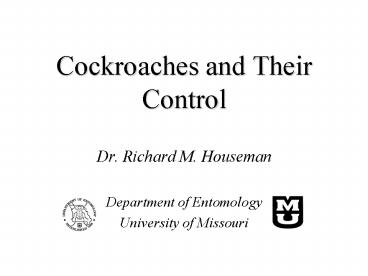Cockroaches and Their Control - PowerPoint PPT Presentation
1 / 15
Title:
Cockroaches and Their Control
Description:
... Cockroach Biology Reproduction Chemicals and sound used to attract mates Female attracts male Antennal contact is essential Primarily on cuticle and antennae ... – PowerPoint PPT presentation
Number of Views:778
Avg rating:3.0/5.0
Title: Cockroaches and Their Control
1
Cockroaches and Their Control
- Dr. Richard M. Houseman
- Department of Entomology
- University of Missouri
2
(No Transcript)
3
Cockroaches
- Order Blattaria
- 3,500 species worldwide
- 55 species in U.S.
- Incomplete metamorphosis
- Food Scavengers
- Preferences vary by species
- Warm, moist habitats
- Domestic/peridomestic
- High reproductive capacity
- Oviparous, ovoviviparous, viviparous
4
Life History
- Life Stages
- Eggs
- Normally produced in egg cases called ootheca
- Hatch within 30-60 days, depending on species
- Some species lay no eggs, or they hatch
internally - Nymphs
- Most active feeding stage for molting and growth
- Live for 30-350 days, depending on species
- Adults
- Intermittent feeding and reproduction
- Live for 2-52 weeks, depending on species
5
Cockroach Biology
- Habitats
- Active at night
- Prefer warm, moist environments
- Near food and water sources
- Protected harborages are very important
- Domestic species occur indoors
- Peak feeding just after dark and just before dawn
- Peridomestic populations not limited to indoors
- Peak feeding after dark until middle of night
6
Cockroach Biology
- Feeding and Nutrition
- Cockroaches are not proudjust hungry
- Chewing mouthparts
- Feed on a wide variety of things--starches,
greases, sweets, decaying organic matter, feces,
garbage, etc. - Contamination
- Regurgitation and defecation on food
- Pheromone secretions (characteristic odor)
7
Cockroach Biology
- Reproduction
- Chemicals and sound used to attract mates
- Female attracts male
- Antennal contact is essential
- Primarily on cuticle and antennae
- Copulation
- May last for hours
- Package of sperm deposited
- Males of some species seal vaginal opening
8
Missouri Cockroaches
- 5 Common Species
- German
- Brown-banded
- American
- Oriental
- Pennsylvania wood
- Domestic and peridomestic
- Can be identified by the egg case or adult stage
9
Domestic Cockroaches
- German cockroach
- (Blatella germanica)
- ½ inch grayish-tan two stripes pronotum
- ootheca slender, 1/3, light brown
- Ootheca carried for 3weeks
- 1 day 30-40 eggs 4-8 ootheca
- Nymphs stage lasts 35-60 days
- Adults live 4-6 months
- Variety of foodstuffs
- Mostly kitchens and bathrooms
10
Domestic Cockroaches
- Brown-banded cockroach
- (Supella longipalpa)
- ½ inch red-brown light stripe across abdomen
- ootheca small, 1/4, barrel-shaped
- Attached ootheca
- 40-60 days 18 eggs 12-16 ootheca
- Nymph stage 3-5 months
- Adults 4-8 months
- Variety of foodstuffs
- Throughout homes
- Appliances, ceilings, walls
11
Peridomestic Cockroaches
- American cockroach
- (Periplaneta americana)
- 1½ inch red-brown yellow margin of pronotum
- ootheca large, gt1/3, barrel-shaped
- Attached ootheca
- 30-50 days 14 eggs 16-20 ootheca
- Nymph stage 6-20 months
- Adults 12-14 months
- Decaying organic matter
- Moist, shady areas outdoors
- Drains, basements, boiler rooms inside
12
Peridomestic Cockroaches
- Oriental cockroach
- (Blatta orientalis)
- 1 inch dark brown shiny no distinctive
markings - ootheca large, gt1/3, barrel-shaped
- Attached ootheca
- 40-60 days 16 eggs 6-8 ootheca
- Nymph stage 6-20 months
- Adults 12-14 months
- Decaying organic matter, filth
- Moist, shady areas outdoors
- Sewers, drains, basements inside
13
Peridomestic Cockroaches
- Wood cockroaches
- (Parcoblatta pennsylvanica)
- 2/3 inch dark brown slender yellow margin on
pronotum, wings - Ootheca slender, curved, gt1/3
- Ootheca deposited under bark
- Rarely breed indoors
- Nuisance pests in May, June
- Decaying organic matter
- Incidental invaders
- Infested firewood often the cause
14
Cockroach Control
- Cultural
- Sanitation is key
- Chemical (gt200 products)
- Baits
- Most important part of roach control
- Should be placed near harborage
- Nymphs most susceptible
- Adult females less susceptible
- Dont place in treated areas
- Can be transmitted via feces
15
Cockroach Control
- Chemical
- Liquids
- Crack and crevice spray
- Directed at harborage
- Helpful to get females
- Quick knockdown
- Space sprays
- Gives some residual activity
- Shouldnt use this during baiting program































